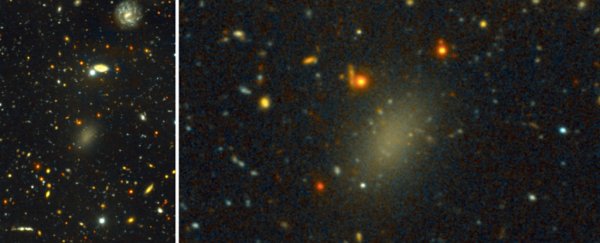Key Takeaways:
- Discovery of a galaxy, Dragonfly 44, with a mass comparable to the Milky Way but containing less than 1% of its stars, primarily composed of 99.99% dark matter, challenges existing astronomical understanding.
- Dark matter, comprising an estimated 27% of the observable Universe’s mass and energy, remains undetectable by conventional means, yet its gravitational influence is crucial for galactic stability.
- Dragonfly 44’s discovery sheds light on the significant role dark matter plays in galactic formation and stability, prompting a reevaluation of existing theories about galaxy formation and evolution.
- Measurement of the velocities of stars in Dragonfly 44 revealed its mass, approximately 1 trillion times more massive than the Sun, indicating an overwhelming dominance of dark matter in holding the galaxy together.
- The existence of a galaxy primarily consisting of dark matter challenges prevailing models of galaxy formation, prompting a rethinking of how these cosmic structures evolve.

In a groundbreaking revelation, astronomers have stumbled upon a cosmic enigma, Dragonfly 44, a colossal celestial body that challenges the very fabric of our understanding of galaxies.
This gargantuan discovery, bearing a mass akin to our Milky Way, defies convention by harboring a mere fraction—less than 1%—of stars found in our galactic neighbor. What’s more perplexing is that this ‘ghost galaxy’ is composed overwhelmingly of dark matter, constituting a staggering 99.99% of its content.
The elusive nature of dark matter, an ethereal substance making up a significant portion of the Universe’s mass and energy, has confounded scientists for decades. It remains elusive, evading traditional detection methods as it neither emits observable radiation nor light. Despite its intangibility, dark matter holds the key to maintaining the cosmic equilibrium, preventing galaxies from self-destruction owing to their swift rotational speeds.
Dragonfly 44’s unmasking occurred in 2014 when astronomers, utilizing the WM Keck Observatory and Gemini North Telescope, stumbled upon a series of ethereal galaxies clustered within the Coma Cluster, situated a staggering 320 million light-years away. Dubbed as ‘fluffy galaxies,’ these ethereal entities intrigued researchers, particularly because of their improbable survival amidst a region teeming with dark matter and frenzied galactic motion.
Further exploration by Pieter van Dokkum and his team delved into the mystery shrouding Dragonfly 44. By meticulously measuring the velocities of stars within this enigmatic galaxy over several nights, they unlocked its secrets.
Astonishingly, their findings revealed a mass surpassing a trillion times that of our Sun, a weight too immense to be upheld solely by its visible stellar constituents. This discovery strongly implies that dark matter predominantly orchestrates the cosmic ballet within Dragonfly 44, offering a compelling testament to its gravitational prowess.
This revelation, however, opens a Pandora’s box of inquiries, shattering existing paradigms about galaxy formation and evolution. The unexpected magnitude and preeminence of dark matter within Dragonfly 44 challenge conventional theories, demanding a reevaluation of our understanding of the cosmos’ intricate dance of creation and destruction.
The newfound knowledge prompts a pressing need to reassess the mechanisms governing the genesis and sustenance of colossal galactic structures.
The implications of Dragonfly 44 extend far beyond the confines of this enigmatic entity. Its existence sparks a fundamental rethinking of our cosmic narrative, confronting astronomers with questions that defy conventional wisdom.
Marla Geha, an astronomer from Yale University, underscores the necessity for a radical reconsideration of galaxy formation theories in light of this unprecedented discovery, underscoring the potential need for a complete rewrite.
The study’s publication in the Astrophysical Journal Letters marks a pivotal moment in our quest to unravel the mysteries of the cosmos. Dragonfly 44 stands as a sentinel, beckoning scientists to delve deeper into the abyss of dark matter, challenging them to decipher the secrets it holds and pushing the boundaries of our cosmic comprehension.
As we gaze upon this ‘ghost galaxy,’ it invites us to rethink our cosmic narratives and explore the vast expanse of the unknown that lies beyond our celestial horizon.


